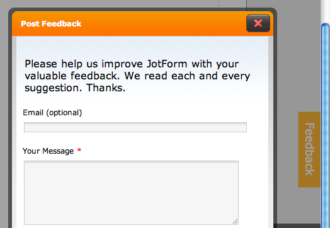It keeps you up for 24hrs straight completing a passion project without checking the clock.
Come Monday morning (when you need to nail down that boring PowerPoint), it’s floated into the stratosphere…
Motivation. It’s a powerful beast.
Often, a sustained blast of it is all we need to kickstart a new career or complete a personal goal. And if we could harness it every day — well, we’d be unstoppable.
Unfortunately, it’s rarely that simple. Motivation is hard to summon and harder to keep alive. As a resource, it’s as finite as they come (see also: its ever-flakey brother, inspiration).
That’s why few people can sustain a constant high charge of self-motivation: things tend to fizzle out somewhere in between the steep rush of excitement and the formidable endpoint.
Pro Tip
Gather valuable feedback online and improve your business. Create a feedback form today! Create a feedback form today!
I believe that to manage motivation as effectively as possible — to tame this elusive, fleeting energy — it needs to be part of a built-in loop that regenerates itself.
Like a timeshare, it becomes bigger, stronger and more powerful when others feed into it.
So how can we motivate others — and in turn become more motivated ourselves?
Types of motivation
Positive motivation follows emotional pleasure, whereas negative motivation serves us to avoid emotional pain.
Basically, we won’t act until the pain of not doing something outweighs the pain of doing it, and visa versa.
Positive motivation stems from our desire to seek out pleasure, and propel ourselves forward when there’s a reward on offer. Those rewards can be tangible: for example, if you were offered $100 for every time you went on a run.
On the flipside, negative motivation takes shape when you have something to lose, and stems from fear. For example, you would be more likely to stick to a diet if you had to risk $500 of your own money on the promise of losing weight.
The most powerful type of motivation, however, is emotional. This often falls under the umbrella of feedback. Positive feedback boosts our self-esteem and sense of wellbeing, encouraging us to repeat the action that generated these feelings.
Negative feedback can be equally, if not more, effective: in The Positive Power of Negative Thinking, psychologists Julie Norem and Nancy Canton’s research illustrates how “there are times when pessimism and negative thinking are indeed positive psychology, as they lead to better performance and growth.”
Both types of feedback can result in positive change. But which is more motivating?
What motivates more: negative or positive feedback?
Opinions are divided on this.
Positive feedback should be detailed, increasing someone’s commitment by enhancing their confidence and self-esteem.
Negative feedback should be informative, offering insights on how to improve and where to expend your efforts.
But ‘positive’ feedback often verges on banal (‘Your work is very good.’ ‘Well done’), or lapses into backslapping.
That’s not going to stick in anybody’s mind.
On the other hand, ‘negative’ feedback can sting for years or even decades, just because someone had a bad day and felt like venting (‘You’re always so sloppy’. ‘You just can’t string a sentence together.’)
Neither of these will motivate.
Myself, I don’t always find the distinction between positive vs. negative that helpful in the first place.
Tim Harford, author of “Adapt: Why Success Always Starts with Failure,” makes a similar point when he says that labeling feedback as ‘positive’ and ‘negative’ is unhelpful:
“It’s not useful to say, ‘That’s really good, or that’s really bad. We need to separate the emotional side from the technical points.”
By ‘the technical points’ Harford means the characteristics of action, a behavior or an outcome, rather than how we feel about it.
And that gets right to the point. Because what motivates people is knowing that their work, or their actions, are noticed. Knowing that someone cares.
Feedback that achieves this will be observant and specific. It won’t get stuck on one-off mishaps but will spot (and point out) ineffective patterns.
Sheryl Sandberg telling a Google employee that saying ‘umm’ every three words sounded stupid is a stellar example of this.
Was her feedback ‘negative’? I suppose so. But that’s not the point. The delivery showed that Sandberg had been paying attention and that she was invested enough to spot detail and to be honest about it.
That’s why the employee was able to hear it without getting defensive, and that’s why it motivated her to change.
In a work environment, almost everybody wants to know how they’re doing:
‘You’ve attended all our Monday meetings since June.’ ‘Your body language during that speech was open and non-defensive.’
Positive? Perhaps. But the key point is that someone noticed, and kept noticing, and took the trouble to articulate it.
That’s what motivates.
Regular, scheduled feedback motivates more
If skillful feedback is about paying attention, then it follows that giving it in small doses, focused on short time spans, is going to be more effective.
Unless you’ve got a mind like Sherlock Holmes (and he wasn’t even real), it’s almost impossible to give attentive feedback that stretches back over long periods.
According to a recent research from PwC, nearly 60% of polled employees would like feedback from their bosses on a daily or weekly basis.
And I’ve found the same over my 12 years of managing over 110 employees at Jotform.
As soon as feedback stops feeling like a big, scary deal, and instead something that we all expect to give and receive, it becomes easier to process and implement.
We get our 3.7 users involved in our feedback-driven culture, too.
Whenever we build a new feature or create a new mock-up for the website, we conduct user testing to make sure our ideas are coming across the way we hope.
This lets us nip any issues in the bud before they morph into something bigger, and means we only have the needs of people who actually use our product to answer to.
Plus, when feedback becomes an everyday routine, it’s less likely to slip into sweeping statements (‘You’re incredibly smart’ ‘You’re always late’): lazy generalizations should never substitute for careful observation.
The incident, or pattern, will be fresh in everyone’s minds, and the discussion will be fact-based and focused.
To motivate, you need to get the balance right
Skillful feedback is always going to be a mixture, for the simple reason that nobody gets everything right — or everything wrong.
But that doesn’t mean the mixture needs to be fifty/fifty.
Interesting research has been done about feedback’s effectiveness in varying doses. For instance,
67% of employees whose managers focus on their strengths are engaged at work, compared to 13% whose managers focus on their weaknesses.
In other words, to feel motivated, people need to get more feedback on what they’re doing right than on what they are doing wrong.
That’s not surprising. Negative feedback can be disengaging, due to its “sting”: we consciously associate it with physical pain, as the neurological pathways for both are the same.
Naturally, it’s harder to tolerate in large amounts.
A key factor seems to be whether negative feedback is experienced as supportive or critical: research shows that even ‘learning orientated’ employees have a defensive response to criticism.
Criticism undermines. And when we feel threatened, our productivity and ability to process information drops. David Rock, director of the Neuro-leadership Institute, explains the neuroscience behind this:
“People’s fields of view constrict, they take in a narrow stream of data, and there’s a restriction in creativity.”
So, it’s generally a good idea to tilt the balance of your feedback towards descriptive praise.
But there is one thing you need to take into account.
Beginners and experts respond differently to feedback
We’re a culture who, rightfully, shy away from hurting feelings. But we forget the purpose of feedback — it’s not to make people feel better, it’s to help them do better.
So how do we make people do better? The answer is, it depends on who they are.
Because here’s a surprising fact:
If you give an elite athlete 100% positive feedback, their performance gets worse. But if you give a complete beginner anything other than 100% positive feedback, they are far more likely to quit.
As people gain expertise, feedback serves a different purpose.
Plenty of interesting research has been done on this.
“Tell Me What I did Wrong: Experts Seek and Respond to Negative Feedback,” says that experts on a subject seek out negative feedback, while novices crave positive reinforcement.
It figures. When you are essentially clueless, positive feedback puts you at ease and keeps you optimistic to the challenges you’re facing.
But when you’re an expert, you already have confidence. It’s constructive negative feedback that will drive you to the top of your game.
The different tiers of feedback:
- Beginners: Give 100% positive feedback to begin with, and slowly dial down as they become more experienced.
- For the middle-grounders: Offer a mix of both, but state both from a positive perspective.
- For the experts: Give them almost exclusively constructive negative feedback.
Tactics for success
What’s the difference between useless criticism and constructive negative feedback?
According experts, it boils down to the difference between ‘No, but…’ and ‘Yes, and…’
The language of criticism is harsh and judgemental. It carries a strong charge and makes people want to protect themselves; and this gets in the way of people being able to hear the core message (particularly in the case of people who are already very self-critical).
That’s why Disney and Pixar introduced ‘plussing’: finding out what’s already good, and then making suggestions for making it better.
“Plussing allows for both pointed critique and positive feedback simultaneously, so that even such persistent criticism is not deflating” Peter Sims, author of “Little Bets: How Breakthrough Ideas Emerge From Small Discoveries,” explains.
The thing that’s already good can be small and hard to detect. No matter.
There is always something there, and once it’s caught, it can be propelled towards improvement.
Shooting down ideas is easy — and that’s often all that criticism achieves.
But adding a new idea to strengthen something not only changes the tone but moves things forward, helping everyone learn.
That’s what the word ‘and’ does, in contrast with ‘but’, which often implies judgement or struggle.
Here’s a final thought
40% of employees who are largely ignored (no positive or negative feedback) report being actively disengaged; only 2% report being engaged.
And I bet even that two percent weren’t fantastically motivated.
So forget about benign neglect.
Pay attention. Give feedback as regularly as possible, and ask for feedback back whenever you can.
Tailor your feedback mix to who you’re speaking to. Bear in mind that different comments will have a different impact on different people.
Motivation doesn’t need to be a one-man show. It can be fed, regenerated and supported by others.
Give it out and get it back.






















Send Comment:
4 Comments:
More than a year ago
A well researched article. Thanks!!
More than a year ago
Superb article.
More than a year ago
Such a great post!!!
More than a year ago
Great article!!